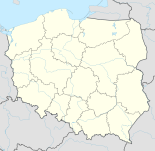Barczewko
| Barczewko | ||
|---|---|---|

|
|
|
| Basic data | ||
| State : | Poland | |
| Voivodeship : | Warmia-Masuria | |
| Powiat : | Olsztyn | |
| Gmina : | [[| Barczewo]] | |
| Geographic location : | 53 ° 51 ' N , 20 ° 35' E | |
| Residents : | 543 (March 31, 2011) | |
| Postal code : | 10-011 | |
| Telephone code : | (+48) 89 | |
| License plate : | NOL | |
| Economy and Transport | ||
| Street : | Łęgajny - Tuławki | |
| Next international airport : | Danzig | |
| Olsztyn-Mazury | ||
| Administration (as of 2010) | ||
| Village chief : | Krzysztof Ludwiniak | |
Barczewko (German Altwartenburg ) is a village in Poland in the Warmian-Masurian Voivodeship . It belongs to the Barczewo commune in the Olsztyński powiat .
Geographical location
The village is located in northeastern Poland. South of Barczewko is the lake Wadąg (Wadangsee) .
history
The town of Wartenburg was located on the site of today's Barczewko at the beginning of the 14th century . This was destroyed by the Lithuanians in the winter of 1353/54. The city was rebuilt a little further east and the village of Altwartenburg was built on the old site of the city. The first documentary mention comes from February 5, 1369. The hand festival was on July 9, 1376 by Bishop Heinrich III. Sorboma renewed. During the equestrian war between the Teutonic Order and Poland from 1519 to 1521 , the place was destroyed. The parish church of St. Catherine was consecrated in 1582. In 1893 the church was rebuilt with romanized forms. The place was destroyed again in 1656 during the Second Northern War .
Based on the provisions of the Versailles Treaty , the population in the Allenstein voting area , to which Alt Wartenburg belonged, voted on July 11, 1920 on whether it would continue to belong to East Prussia (and thus to Germany) or join Poland. In Alt Wartenburg, 540 people voted to stay with East Prussia, 80 votes went to Poland.
After the Second World War the village became part of Poland.
Economy and Infrastructure
The village is on a side road that leads in a south-easterly direction after about five kilometers near the village of Łęgajny to the state road 16 (droga krajowa nr 16) . To the north, the road leads through Tuławki, among other places, and after about 15 kilometers at Orzechowo it joins Voivodship Road 593 (droga wojewódzka nr 593) .
The geographically closest international airport is Kaliningrad-Khrabrovo Airport, which is located about 100 kilometers north in the Russian Oblast of Kaliningrad . The nearest international airport on Polish territory is Gdansk Lech Wałęsa Airport, 150 kilometers northwest .
Personalities
- Karl Langwald (1886–1945), German clergyman and martyr
- Ulrich Fox (1937–2012), German homeland researcher and holder of the Federal Cross of Merit
- Ursula Fox (* 1938), German non-fiction author and recipient of the Federal Cross of Merit
Web links
- District community Allenstein e. V.
- Old Wartenburg
- Literature by and about Barczewko in the catalog of the German National Library
Individual evidence
- ^ CIS 2011: Ludność w miejscowościach statystycznych według ekonomicznych grup wieku (Polish), March 31, 2011, accessed on May 28, 2017
- ↑ Website of the municipality of Barczewo, Sołectwa i sołtysi gminy Barczewo ( Memento of the original from December 17, 2010 in the Internet Archive ) Info: The archive link was inserted automatically and has not yet been checked. Please check the original and archive link according to the instructions and then remove this notice. , accessed November 7, 2010
- ↑ a b c Erich Weise (ed.): Handbook of historical sites . Volume: East and West Prussia (= Kröner's pocket edition . Volume 317). Unchanged reprint of the 1st edition 1966. Kröner, Stuttgart 1981, ISBN 3-520-31701-X , p. 4.
- ↑ a b Szukacz.pl Barczewko - Informacje dodatkowe , accessed on November 7, 2010
- ↑ Herbert Marzian , Csaba Kenez : self-determination for East Germany. Documentation on the 50th anniversary of the East and West Prussian referendum on July 11, 1920. Editor: Göttinger Arbeitskreis , 1970, p. 67

